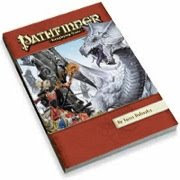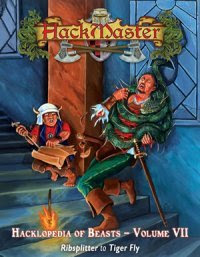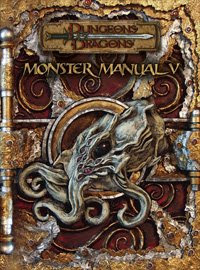Earlier this month over at
theRPGsite we had a thread about OD&D. As is often the case, the old complaint about non-variable weapon damage resurfaced. In case this is new to you, allow me to sum up: Before the release of
Supplement I: Greyhawk all weapons did d6 damage. This annoys a lot of people used to each weapon getting its own damage range based upon how kill-rific it is supposed to be. "Why would you ever wield a two-handed sword if it was just as deadly as a dagger?" is the inevitable question. Any OD&D ref using the weapon-versus-armor chart and weapon speed rules in
Chainmail can handily answer that question, but it appears to me that the games that actually used
Chainmail with OD&D have always been in the minority. Here's how I fielded the issue on the thread in question.
For my next OD&D outing I plan on using the following scheme for damage:
Fighter Types
Light weapons (club, dagger): roll 1d6
Most weapons: roll 2d6, take better roll
Two-handed weapons, lance: roll 3d6, take best roll
Clerics, Normal Men, and most Humanoids
Light Weapons: roll 2d6, take lower roll
Most weapons: roll 1d6
Two-handed weapons, lance: roll 2d6, take better roll
Magic-Users, Kobolds, and other wimps
Most Weapons: roll 2d6, take lower roll
Two-handed weapons: roll 1d6
The basic goal here is to keep damage ranges in the 1 to 6 zone of the original rules, but to allow for variation based upon both weapon employed and relative bloodthirstiness of the wielder.
The OD&D ref community spins out things like this
all the time. I can't really claim this schema as my own. I'm basically riffing off
Philotomy's awesome house rules combined with an idea from a dude over at
Knights & Knaves and leavened with a bit from an old thread in the
Dragonsfoot Classic D&D subforum, all of which came to a bubble over at the Original D&D Discussion Forum, or as I like to call it
Odd74.
Indie dude Levi Kornelsen has been talking this sort of thing over at his livejournal, particularly
here and
here. He observes two features that can make an RPG system really juicy: having something cool to do between sessions (fiddling with houserules, making new monsters, laying out subsectors, tweaking your PC build) and having a game that's
imperfect and
incomplete in inspiring ways. The combo of fun things to do plus either critical gaps or unnecessary elaboration is why I keep plugging away at games like
Encounter Critical and the older, crappier versions of D&D.
In my opinion 2nd edition AD&D was mechanically superior to 1st edition in many ways. Stripping out the succubi and half-orc assassins made the game a lot less
cool, but the system ran pretty dang smoothly. Similarly, the Rules Cyclopedia is probably the single best incarnation of the game ever published. But I rarely open my copy of the RC, much less play it. And I don't even own all the 2nd edition corebooks. Why? I'm starting to think it's because those games are literally
too good for me.
Clearly no one needs a mechanically perfect game to have fun playing RPGs, or we'd have all quit a long time ago. But thinking about why I like the games I like, especially in light of Levi's comments, and now I'm wondering if maybe I don't
want a mechancally perfect game. The tinkerer in me is better served by an engine that isn't already purring like a kitten. And at the table a broken game only encourages me to operate more by the seat of my pants, which is when my GMing is at its best.
I'm not arguing that More Broken equals Better, by any means. Game designers, please keep working and playtesting and all that stuff! I'm just offering a counterpoint here to the "System Does Matter" and "Design is Law" types out there. Yes, your game system is important, but sometimes maybe the hardcore of the hobby fetishize the perfect system when a lot of that energy can go towards just making up some shit and running with it.
Am I making any sense here? I feel like I'm kinda all over the map in this post. To start the posty by showing off my shiny new OD&D houserule and to end it with arguing that system matters less seems pretty dang stupid.













 Ironface!
Ironface!







